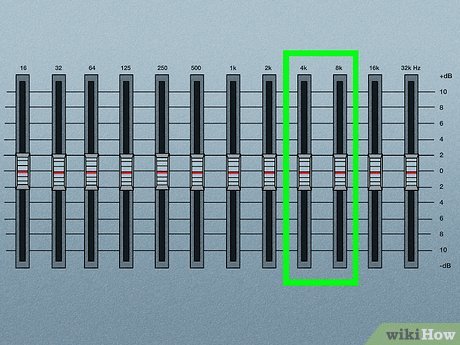9 Best Equalizer Settings for Bass: Boost Your Music Experience
Ever wondered how to make your favorite tracks thump with that perfect bass? Whether you’re a casual listener or an audiophile, tweaking your equalizer settings can transform your music experience. With the right adjustments, you can enhance the bass, making every beat feel more powerful and immersive.
In this article, you’ll discover the 9 best equalizer settings for bass that can elevate your sound system. From subtle enhancements to deep, resonant lows, these settings will help you fine-tune your audio to perfection. Dive in and find out how to make your music not just heard, but felt.
Flat EQ Setting: The Natural Baseline
The Flat EQ Setting keeps all frequencies at the same level. This can be an excellent starting point for tweaking your audio.
What Is Flat EQ Setting?
A Flat EQ Setting means each frequency band is set to zero dB. It doesn’t boost or cut any frequency. This setting provides a neutral audio experience, helping you understand how your system naturally sounds. Many audiophiles use flat settings to baseline audio before making alterations.
When to Use a Flat EQ Setting for Bass
Use a Flat EQ Setting when you want to experience your music as the artist intended, without any enhancements. This is perfect for assessing the natural response of your speakers or headphones. If you’re starting with EQ adjustments, flat helps you hear the original mix before adding bass enhancements.
Bass Boost Setting: Amplifying Low Frequencies
Defining Bass Boost
Bass Boost increases the lower frequencies in your audio, making bass sounds fuller and more pronounced. It typically emphasizes frequencies around 60-250 Hz, enhancing the depth and impact of instruments like bass guitars and drums. This setting is ideal for those who crave a richer, more immersive listening experience, adding power and presence to your music.
Ideal Scenarios for Using Bass Boost
Use Bass Boost when listening to genres like hip-hop, EDM, and reggae, where bass lines play a central role. It’s also excellent for boosting the low-end frequencies when using smaller speakers or headphones that might lack strong bass response. If you’re watching movies with intense soundtracks or playing games that feature heavy bass effects, this setting will make the audio feel more impactful and engaging.
R&B/Soul Focus: Smooth and Deep Bass Lines
R&B and Soul music often rely on smooth, deep bass lines to create the genre’s distinctive sound. Tailoring your EQ settings can help you experience the richness and nuance of these bass-driven tunes.
Tailoring EQ for R&B and Soul Genres
R&B and Soul genres benefit from EQ settings that emphasize warm, rounded bass tones without overshadowing vocals and mid-range instruments. To achieve this balance, you’ll want to boost the lower frequencies gently while ensuring clarity in the mids and highs.
- Low Frequencies (20-250 Hz): Boost slightly – about +3 to +5 dB – to add depth and warmth to the bass lines without causing muddiness.
- Mid-Low Frequencies (250-500 Hz): Increase by +2 dB to enhance the fullness of bass guitars and kick drums.
- Mid Frequencies (500-2000 Hz): Keep balanced to maintain vocal clarity and the presence of key mid-range instruments.
- High Frequencies (2000-8000 Hz): Apply a slight boost of +2 dB if needed for additional clarity and definition in vocals.
- Upper High Frequencies (8000-20000 Hz): Boost minimally, about +1 dB, to add shimmer and detail to cymbals and hi-hats without creating harshness.
Utilizing these EQ settings will help you enjoy the smooth, deep bass lines of R&B and Soul music, bringing the full richness of the genre to life in your listening experience.
Rock and Heavy Metal: Punchy Bass for Intense Sounds
For rock and heavy metal, having punchy bass is crucial to complement the aggressive guitar riffs and powerful drums.
EQ Adjustments for Rock Music
Boosts in the 60-100 Hz range will enhance the lower bass frequencies, delivering a punchier sound. Reduce the mid-bass around 200-250 Hz slightly to avoid muddiness. Increasing the high-mids between 2-4 kHz can help guitars cut through the mix.
Key Frequencies to Enhance for Metal Genres
In metal genres, boost the 40-80 Hz range to give depth to the kick drum and bass guitar. Enhancing the 1-2 kHz range can bring out the snarl in distorted guitar tones. Reducing anywhere from 300-500 Hz will help clear any unwanted boominess, making the mix tighter and more defined.
Hip-Hop and EDM: Boosting Beats and Bass
For genres like hip-hop and EDM, you’ll want to emphasize the heavy beats and powerful basslines to elevate your listening experience.
Special EQ Settings for Hip-Hop
Boost low-end frequencies. Elevate the 20-60 Hz range to bring out the thumping bass. Increase the 60-200 Hz range slightly for a fuller bass sound, without overpowering the vocals.
Enhance vocals and snare. Raise the 1-3 kHz range to make vocals stand out. Boost 3-6 kHz for clearer snare drums.
Control high frequencies. Lower the 6-10 kHz range accordingly to reduce harshness, and slightly increase 10-20 kHz for added brightness and crispness.
Adjusting Bass in Electronic Dance Music
Maximize sub-bass impact. Increase the 20-50 Hz range for those deep, rumbling sub-bass elements that drive many EDM tracks.
Balance mid-bass. Boost the 50-200 Hz range to fill out the bass, ensuring it complements the kick drums without muddying the mix.
Clarify mids and highs. Elevate the 2-5 kHz range to make synths and melodies shine. Adjust the 10-15 kHz range for added sparkle and clarity to high-end elements such as hi-hats and claps.
Jazz and Blues: Subtle Bass Enhancements
How to Set EQ for Warm, Smooth Bass in Jazz
Boost low-mid frequencies (around 250-500 Hz) slightly to add warmth and richness to the bass. Reduce sub-bass (below 60 Hz) to avoid muddiness. Enhance frequencies between 1-2 kHz to bring out the natural resonance of acoustic bass instruments. Consider a slight cut around 3-4 kHz to smooth out any harshness in the upper mids. Jazz benefits from a balanced and emotive bass, so fine adjustments are key.
Maintaining Balance in Blues with EQ Settings
Increase the 100-200 Hz range to give basslines more presence without overpowering other instruments. Boost mid-bass frequencies (500-700 Hz) moderately to add warmth and fullness. Ensure vocals and lead instruments remain clear by reducing bass around 300-400 Hz where necessary. Enhance the clarity of guitars and vocals by slightly lifting frequencies between 2-4 kHz. Blues thrives on a clean, well-rounded sound, so maintaining balance is essential.
Classical Music: Defined and Present Bass
When adjusting EQ settings for classical music, aim for defined and present bass to enhance the listening experience without compromising the overall sound quality.
EQ Tips for Enhancing Bass in Classical Music
- Boost Low-Mid Frequencies: Start by slightly boosting frequencies between 60 Hz and 250 Hz. This range targets cellos, double basses, and bassoons, providing a rich foundation without muddiness.
- Enhance Sub-Bass Frequencies: Adjust frequencies around 20 Hz to 60 Hz. Subtle increases here add depth, making string basses and contrabasses more pronounced without overwhelming the orchestra.
- Balance Upper Bass Frequencies: Focus around 250 Hz to 500 Hz to ensure bass instruments’ clarity in ensemble passages. Fine-tuning this range helps maintain the bass’ presence without interfering with midrange instruments.
- Apply Gentle Adjustments: Use modest boosts and cuts to avoid overpowering other instruments. Overly aggressive changes can disrupt the harmonic balance and muddy the composition.
- Utilize High-Pass Filters: Apply a high-pass filter to remove unnecessary rumble below 20 Hz. This practice maintains a cleaner sound stage by reducing inaudible frequencies that can muddy the mix.
- Monitor Overall Mix: Continuously listen to the entire mix to ensure no specific frequency range overwhelms the others. Adjustments should complement the music’s natural dynamics, keeping the bass prominent but balanced.
- Consider Room Acoustics: Remember how your playback environment affects bass perception. Rooms with lots of hard surfaces can amplify bass frequencies, so make adjustments accordingly to prevent an overpowering low end.
Custom EQ Setting: Personalizing Your Bass Experience
Fine-tuning your audio settings allows you to create a listening experience tailored to your tastes. Below, we’ll guide you on how to craft your own EQ settings and offer tips for experimenting with different levels.
Crafting Your Own EQ Settings
Start with a flat EQ setting to understand the baseline sound. Gradually adjust frequencies from there. Boost frequencies around 60-250Hz to enhance bass. Decrease the mids (500Hz-2kHz) slightly if they overpower the bass. Tweak the high frequencies (>5kHz) for clarity without losing bass depth.
Tips for Experimenting with Different Levels
Experiment with small adjustments first. Listen to various genres and note changes. Use quality headphones or speakers to hear precise differences. Test your settings at different volumes to ensure consistent quality. Save your custom settings for easy access.
Conclusion: Getting the Most Out of Your Bass EQ Settings
Fine-tuning your equalizer settings can transform your listening experience, bringing out the depth and richness of your favorite music. By understanding how to adjust frequencies for different genres and instruments, you can create a more immersive and enjoyable sound.
Experiment with custom settings to find what works best for you. Start with a flat EQ and make small adjustments, paying attention to how each change affects the overall sound. Use quality headphones or speakers to ensure you’re hearing the true impact of your tweaks.
Remember, the goal is to enhance the bass without overpowering other elements. With patience and practice, you’ll master the art of EQ adjustments, making every listening session a sonic delight.






